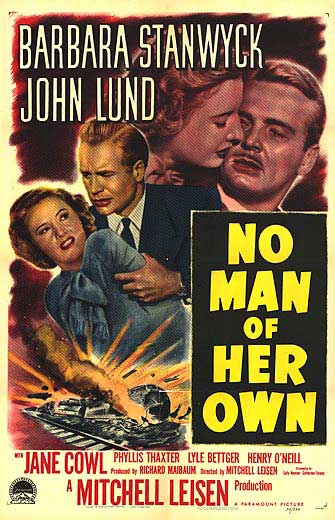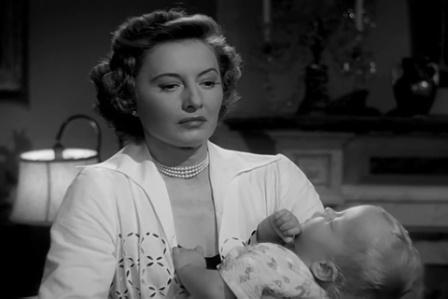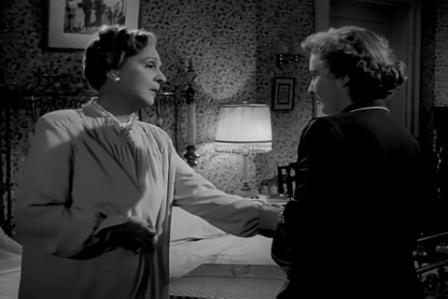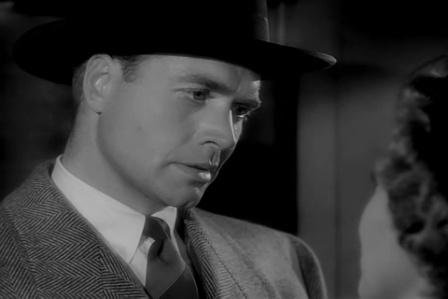 1950 was a busy year for Barbara Stanwyck as she starred in four films that year. Among them was No Man of Her Own, what today would be called a ‘woman’s picture.’ Or would it? For the first two thirds of the picture it’s a somber and almost depressing affair (don’t confuse somber and depressing with bad, however). During the last half hour the picture takes a decidedly noir turn, only to cap things off with a decidedly un-noir happy ending.
1950 was a busy year for Barbara Stanwyck as she starred in four films that year. Among them was No Man of Her Own, what today would be called a ‘woman’s picture.’ Or would it? For the first two thirds of the picture it’s a somber and almost depressing affair (don’t confuse somber and depressing with bad, however). During the last half hour the picture takes a decidedly noir turn, only to cap things off with a decidedly un-noir happy ending.
From start to finish though, Stanwyck drives it all.
As the picture opens Helen (Stanwyck) is travelling to visit Steve (Lyle Bettger), the father of her unborn son. Shacked up with a new woman and refusing to see her, he slides a train ticket back home under his door which sobbingly she accepts.
On the train back she meets Hugh and Patrice Harkness, who befriend her and the three become travelling companions for the trip. While washing her hands, Patrice asks Helen to briefly wear her wedding ring as she’s afraid of losing it in the drain. As soon as she slides the ring on her finger everything goes black as the train derails.
 When Helen comes to, she finds herself in the hospital. Her baby has been born and stranger still she’s been identified as Patrice Harkness from the wedding ring she’s wearing. Further, her two travelling companions (her ‘husband’ and ‘Helen’) failed to survive the crash.
When Helen comes to, she finds herself in the hospital. Her baby has been born and stranger still she’s been identified as Patrice Harkness from the wedding ring she’s wearing. Further, her two travelling companions (her ‘husband’ and ‘Helen’) failed to survive the crash.
Before she can correct them she finds herself in the Harkness home with her new in-laws, who are quick to assume-no questions asked, mind you- that she is their son’s wife and that her child is their grandchild. Among them are mother-in-law Mrs. Harkness (Jane Cowl in her final role), Henry O’Neill as Mr. Harkness, and John Lund as brother-in-law Bill.
Adopting her new identity as Patrice, Barbara Stanwyck becomes part of the family, though not without some consternation and ‘near misses’ on being exposed. At several instances she’s almost ready to disappear back to her life as Helen.
 A romance begins to develop between Patrice and Bill, in spite (or perhaps because) of the fact that it seems clear that Bill is on to the ruse. As he begins to introduce her to his circle of friends, Steve reappears to Patrice and threatens to expose her.
A romance begins to develop between Patrice and Bill, in spite (or perhaps because) of the fact that it seems clear that Bill is on to the ruse. As he begins to introduce her to his circle of friends, Steve reappears to Patrice and threatens to expose her.
Patrice pays him off, only to find that (of course) he doesn’t leave, instead making greater requests of her. After being forced to secret marry Steve, she finally has had enough and heads back to the Harkness estate. Retrieving a gun, she returns to Steve’s apartment and shoots him.
Returning home, she lets Bill in on what she’s done and after a bit there’s a knock at the door. Knowing that it is the police, they prepare for the worst and open the door. Distraught, Patrice confesses to the murder only to be told that Steve was instead killed by still another woman angry at his constant womanizing. They are confident that Patrice isn’t the murderer as her gun is of an entirely different caliber.
 As good as No Man of Her Own is- and it is a good picture- it isn’t without its flaws. To really enjoy it you have to suspend belief more than a few times. From the implausibility of the train wreck (superior special effects aside) to Patrice’s rapid acceptance into the Harkness home there is a lot that doesn’t make a lot of sense.
As good as No Man of Her Own is- and it is a good picture- it isn’t without its flaws. To really enjoy it you have to suspend belief more than a few times. From the implausibility of the train wreck (superior special effects aside) to Patrice’s rapid acceptance into the Harkness home there is a lot that doesn’t make a lot of sense.
There’s also Bill’s seeming inability to pick up on all the clues that Patrice is really Helen and Patrice’s shooting of Steve. Bill’s sees Patrice sign ‘Helen’ when pen shopping yet fails to ask her about it. When Patrice goes into Steve’s place, he’s clearly dead before she shoots him- it’s also pretty clear that she missed him.
Stanwyck is by far the reason to see this film as she’s a dominating presence in almost every scene. Granted, she might have been a touch old to play the role but she seems to revel in her role, especially in the first two-thirds where she is visibly torn at the position she’s found herself in and stays in the odd situation more for the future of her son than her own well being.
 John Lund, though highly accomplished, seems dim and perhaps just along for the ride. Apart from his inability to deduce Patrice isn’t all she claims to be there isn’t much going on here. He plays well with Stanwyck, however, but he can’t hold his own with her in the few especially powerful scenes they have together.
John Lund, though highly accomplished, seems dim and perhaps just along for the ride. Apart from his inability to deduce Patrice isn’t all she claims to be there isn’t much going on here. He plays well with Stanwyck, however, but he can’t hold his own with her in the few especially powerful scenes they have together.
Lyle Bettger as Steve is quite good, with most all of his time coming in the last noirish final third of the picture. No Man of Her Own should definitely be added to his canon of snarky and dark characters. He’s exceedingly strong here in being menacing without losing an odd sense of debonair charm. Take a look at his scene at the night club where he reintroduces himself to Patrice and makes his initial blackmail request of her.
Let’s take that final third of the picture where things go very noir. Though the entire picture is shot full of shadows and darkness- for many of the scenes note how the cast’s faces simply fade into a surround blackness- it is the final third where the tone shifts from the weepy women’s picture we’ve enjoyed thus far to a sinister game of blackmail.
 Strange as it seems, director Mitchell Leisen makes it all work. Cleverly by the time Steve reappears we’ve just about forgotten he exists, so complete is our immersion in the Harkness household. The only flaw, if there is one, is the finale, which seems a bit clunky and tacked on. A much more powerful ending (though surely not permitted at the time) may have been letting Patrice head to custody for a murder she in reality did not commit.
Strange as it seems, director Mitchell Leisen makes it all work. Cleverly by the time Steve reappears we’ve just about forgotten he exists, so complete is our immersion in the Harkness household. The only flaw, if there is one, is the finale, which seems a bit clunky and tacked on. A much more powerful ending (though surely not permitted at the time) may have been letting Patrice head to custody for a murder she in reality did not commit.
Sadly No Man of Her Own has been rather overlooked in Stanwyck’s filmography. It shouldn’t be as she delivers a magnificent performance which overcomes all of the plot holes and related lunacy she’s place in throughout.